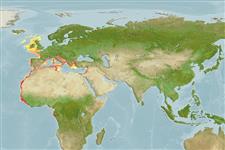Classification / Names
Common names from other countries
Main reference
Size / Weight / Age
Max length : 230 cm TL male/unsexed; (Ref. 5377); common length : 150 cm TL male/unsexed; (Ref. 3593); max. published weight: 103.0 kg (Ref. 11036)
Length at first maturity
Lm ?, range 80 - ? cm
Environment
Marine; brackish; benthopelagic; oceanodromous (Ref. 51243); depth range 15 - 300 m (Ref. 2683)
Climate / Range
Subtropical, preferred 18°C (Ref. 107945); 65°N - 6°S, 23°W - 36°E
Distribution
Eastern Atlantic: Norway to Gibraltar and Congo, including the Mediterranean and the Black Sea. Migrated to the Red Sea via the Suez Canal.
Countries | FAO areas | Ecosystems | Occurrences | Introductions
Short description
Dorsal
spines
(total): 10 - 11;
Dorsal
soft rays
(total): 27-29. Rough scales, Second dorsal fin (soft ray) twice as long as first, spiny rayed dorsal fin (Ref. 35388).
IUCN Red List Status (Ref. 115185)
Threat to humans
Harmless
Human uses
Fisheries: commercial; gamefish: yes
More information
ReferencesAquacultureAquaculture profileStrainsGeneticsAllele frequenciesHeritabilityDiseasesProcessingMass conversion
Tools
Special reports
Download XML
Internet sources
Estimates of some properties based on models
Phylogenetic diversity index
PD50 = 0.5020 many relatives (e.g. carps) 0.5 - 2.0 few relatives (e.g. lungfishes)
Trophic Level
4.3 ±0.75 se; Based on food items.
Resilience
Low, minimum population doubling time 4.5 - 14 years (K=0.09)
Vulnerability
High to very high vulnerability (67 of 100)
Price category
